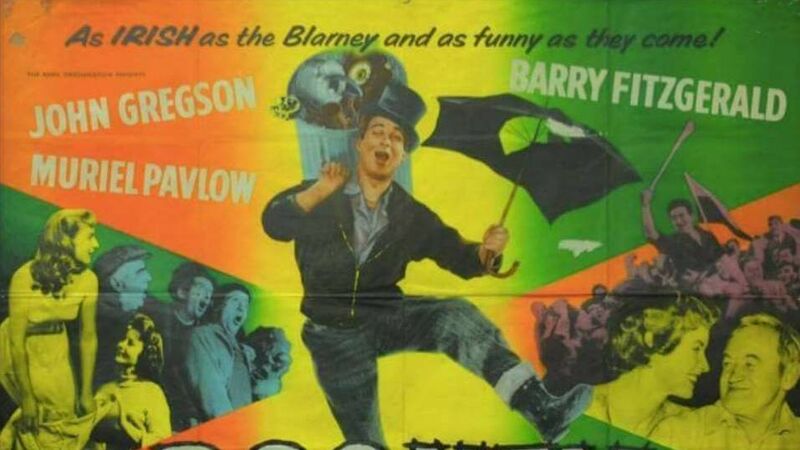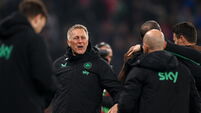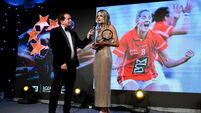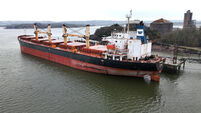Paul Rouse: When Kilkenny gained an extra man in an All-Ireland final parade

Rooney (1958), that features John Gregson, the man who walked in the parade with the Kilkenny team.
On 24 November 2008, Regina Fitzpatrick – a researcher with the GAA Oral History Project – travelled to Ferrybank in Co. Waterford and interviewed Paddy Buggy, former President of the GAA and former All-Ireland winning Kilkenny hurler.
It is an extraordinary interview, running over 4 hours and 12 minutes, Paddy Buggy – by then just about to turn 80 – gave a vivid insight into a lifetime lived in the GAA.
The story began in Slieverue and in Ferrybank, the contested marchlands between Kilkenny and Waterford, back in the years before World War II; and it ended also back in Ferrybank, as he describes the way the Celtic Tiger was changing the area.
The great constant amid vast social change was hurling. It ran through his life and he loved it. He regarded Christy Ring as the best hurler he ever saw, but he spoke with a generosity about the hurlers of every era of his life, regardless of the county they played for.
His greatest achievement as a player was his part in the 1957 All-Ireland hurling final, where he helped Kilkenny defeat Waterford. For a man who lived where he lived, no victory could have meant as much.
The match itself was an absolute classic and the scenes of the day – including the bedlam as the game reached its climax – were beautifully filmed and released to cinema in the days just before the dawn of Irish television.
(The footage of the game can be seen here: https://ifiarchiveplayer.ie/gaa-hurling-1957/ )
Looking at the celebrations that took place when the winning point was scored by the Kilkenny captain Mick Kelly, three minutes from the end of the game, is a reminder of the pure joy that sport can bring.
One of the amazing things about the official film footage released of the day, with its Pathé-news style voiceover by Mícheál O’Hehir, is that it makes no mention of the extraordinary fact that 16 men were walking around wearing Kilkenny jerseys during the pre-match parade.
The Irish Film Board footage shows with great clarity the presence in the parade of the 16 man, but O’Hehir says not a word about what is happening, even though there can be no doubt that he knew precisely what was happening.
The extra man in the parade was John Gregson, an English actor, who was a leading post-war comedy actor in Britain, starring in more than 40 feature films. Gregson was the star of a film called ‘Rooney’, alongside other actors such as Barry Fitzgerald and Noel Purcell, Muriel Pavlow and June Thorburn. The film is an adoption of a Catherine Cookson novel, and directed by George Pollock, who was most celebrated for his ‘Miss Marple’ series.
It’s no classic, but it has charm (in a stage-Irish way) as it unveils the story of James Ignatius Rooney, a binman, who shoots to a very Irish fame when selected for the Dublin hurling team. Rooney lives in digs in the O’Flynn household in Rathmines, meets romance on the way and is almost sidelined by inadvertent thievery. And ends up a county hurling star.
The most amazing things happen in the second half of the film. By the way of these things, Rooney’s Dublin team makes it to the All-Ireland hurling final. The challenge for the filmmakers presented by this was a large one – in a pre-digital age, how could you plausibly generate scenes that might plausibly recreate an All-Ireland final?
The question was answered in a most imaginative way: get Rooney to walk in the parade of the actual All-Ireland final and shoot the crowd scenes of the day itself.
The hurlers of Kilkenny and Waterford received £5 apiece for co-operating with the film, after the GAA had given unprecedented permission to the Rank Film Company to shoot the scenes they needed. This co-operation included coming back up to Dublin to film hurling scenes in Croke Park on the week after the final.
Paddy Buggy was one of those hurlers. He remembered: “It was a simple film about a dustman and a romance and a hurling game.”
“They asked Waterford could John Gregson who was the star of the film, go into the Waterford dressingroom and could he parade with the Waterford team prior to the match? And Waterford thought about it and they felt like they were under stress and strain enough and they didn’t want to break their composure. They wanted to concentrate on the match. And prepare properly for it. And they felt that this would be an aside that might upset them. And they refused.”
But, Paddy Grace – who was in charge of Kilkenny – was a great character and he felt that this stranger togging out with the team might actually be a great distraction in a positive way before the match.
And as Buggy recalled: “He did come tog off with us. And while he didn’t start in the parade, when the parade was under way, he stepped in between Sean Clohessy and myself and he paraded around the pitch with us. He was a fine looking man. He was over 6 feet.”
He may have been a good-looking man, but he was no hurler. The hurling the following Saturday was not easy to film: “We were brought up to Croke Park the following Saturday and we had practice sessions trying to get John Gregson Park trying to hit a hurling ball but he hadn’t a clue. He would never make a go of it. He kind of had a scoop rather than a swing.”
There are many more stories of hurling in this interview, ranging from club underage games to the presidency of the GAA. They are a remarkable testimony to the changing nature of Irish society across more than seven decades and the full interview can be listened to here (https://www.gaa.ie/the-gaa/oral-history/paddy-buggy/)
As well as the insight offered into Irish social and cultural life, the most compelling section relates to Paddy Buggy’s time as President of the GAA and how he managed to lead the Association during the hunger strikes of the early 1980s and their aftermath.
This was exceptionally difficult but the interview offers a vital insight. The fraught nature of these years, the divisions, the strain, the relentless violence are all documented by Paddy Buggy whose decency and dedication shine through at every turn. There is a line in the middle of the interview where he says it is very difficult to get a big ego in the GAA. This is not at all true. But it is definitely true in the case of Paddy Buggy.








